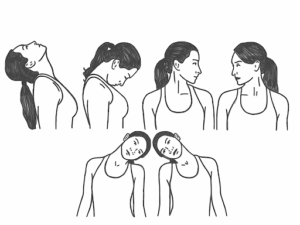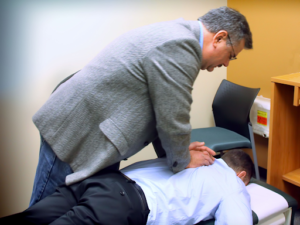Heading back to school can put a strain on your child’s growing frame. Long periods of sitting at a desk and the weight of a backpack can cause neck and back problems. In this article, we are going to give you some tips on how to help your child prevent injury and maintain a healthy posture during the school year.

Practice the 90-90-90 Rule
When your child is sitting at their desk, they are probably tempted to slouch in their chair or hunch over their school work. Both of these postures can have an adverse effect on their growing spine. The 90-90-90 rule is an easy to remember way for your child to know if they are sitting with a healthy posture.
Your child’s knees should be at a 90-degree angle to the floor, and their feet should be flat on the floor, their hips should be at a 90-degree angle, and their elbows should rest at a 90-degree angle on their desk. This means that they are sitting up straight and not straining their neck. If your child’s feet don’t touch the floor when they are sitting at their desk, talk to their teacher about using a smaller chair or a step stool.
Of course, it’s not likely that your child will be able to keep this posture all day, but if you coach them to check their posture whenever they sit back down after leaving their desk, they should end up spending most of their day in a healthy position. Simply maintaining a healthy posture will significantly reduce your child’s risk of developing neck and back problems down the road.

Lighten the Load
Backpacks are a necessity, but if not used properly, they can hurt your child’s back. Wearing backpacks on only one shoulder or using messenger bags as backpacks causes uneven weight distribution that strains the spine. Encourage your kids always to wear their backpacks on both shoulders.
The type of backpack you buy can also make a difference. Look for backpacks with wide padded straps. These distribute weight over a larger area, decreasing the strain on your child’s shoulders and back. There are also some simple changes you can make in how you pack your child’s backpack that will make it safer and more comfortable. Always pack heavier items, like textbooks, towards the back of the backpack and put lighter items towards the front. This way, it won’t be pulling your child backward, and they won’t feel the need to hunch over to balance the weight.
Make sure that the lower strap on the backpack is tightened so that the backpack won’t sag below your child’s hips. Sagging or oversized backpacks also encourage children to hunch forward. In addition to this, keep in mind that the American Acadamy of Orthopedic Surgeons recommends that you make sure that your child’s backpack never weighs more than 20% of their body weight. This can be difficult for teenagers and college students who have more books to haul around. Sometimes a rolling backpack is the best solution for students who have to carry a heavier load.

Get Active
Sitting for six hours isn’t healthy for kids or adults. Prolonged sitting has been shown to have adverse effects not only on skeletal health but on cardiovascular health as well. Weight gain is also a common side effect of a sedentary lifestyle. Extra pounds put a strain on joints and on hearts. It’s important to encourage your child to stay active even after school starts. If your child doesn’t play a sport or participate in some other organized activity, encourage them to be active at home.
Playing in the backyard or a local park after their homework is done is a great way for kids to get exercise and destress from their school day. You could also start a family exercise routine, using a video, or going to the gym together. Staying active is one of the most critical factors in maintaining overall good health. It also helps to keep kids and adults limber and prevent back and neck pain.
Stretch It Out
Teach your kids how to stretch, it is good for their muscles, and it’s a great way to ease stress. The following stretches can be done in class with minimal disruption to other students:

Neck Stretches: This simple stretch involves bringing your chin to your chest, then bending your neck straight back then turning your head side to side, looking as far behind you as possible.
Chest Stretch: Sit on the edge of your seat, in the 90-90-90 posture, sitting with your back straight. Interlock your fingers behind your back and slowly straighten your elbows. Roll your shoulders back and squeeze your shoulder blades together. Be careful not to arch your back. Pull your hands down toward the chair for an even deeper stretch.

Shoulder Stretch: Sit up straight and tall in your chair, bend your right arm in front of you so that the palm of your right hand is in front of your face, straighten your left arm out towards your right side supporting it with your bent arm, then switch sides.
Leg stretch: Only do this stretch if you have enough room in front of you to straighten your leg without kicking anyone. Sitting straight in your chair, raise one leg straight out in front of you at hip level. For a more intense stretch, hold this position while pulling your toes back towards your body. Switch and do the other leg.

Come in for a Tune-Up.
Sometimes kids need a tuneup just like adults do. Taking your child to the chiropractor is both safe and effective. Chiropractors use gentle techniques to correct skeletal problems in children of all ages. Young children sometimes only require light finger pressure to restore mobility to spinal joints. A chiropractor can tell you if your child is suffering the effects of bad posture and give personalized solutions. Many parents have found that chiropractic care is an essential part of maintaining their child’s health through all developmental stages.

